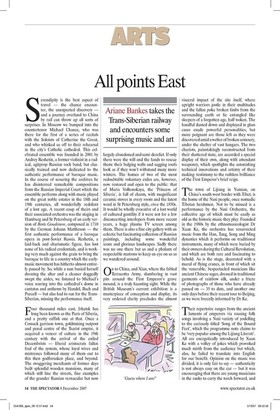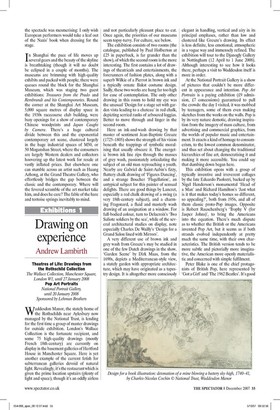All points East
Ariane Bankes takes the Trans-Siberian railway and encounters some surprising music and art Serendipity is the best aspect of travel — the chance encounter, the unexpected discovery — and a journey overland to China by rail can throw up all sorts of surprises. In Moscow we bumped into the countertenor Michael Chance, who was there for the first of a series of recitals with the Soloists of Catherine the Great, and who whisked us off to their rehearsal in the city's Catholic cathedral. This celebrated ensemble was founded in 2001 by Andrey Reshetin, a former violinist in a radical, agitprop Russian rock band, but classically trained and now dedicated to the authentic performance of baroque music. In the course of scouring the archives he has disinterred remarkable compositions from the Russian Imperial Court which the ensemble performs along with music played on the great noble estates in the 18th and 19th centuries, all wonderfully redolent of a lost age. A recent coup of theirs and their associated orchestra was the staging in Hamburg and St Petersburg of an early version of Boris Goudenow, composed in 1710 by the German Johann Mattheson — the first authentic performance of a baroque opera in post-Soviet Russia. Reshetin, a laid-back and charismatic figure, has lost none of his radical credentials, and is working very much against the grain to bring the baroque to life in a country which the earlymusic movement has hitherto almost entirely passed by. So, while a nun busied herself dressing the altar and a cleaner doggedly swept the aisles, we listened to Michael's voice soaring into the cathedral's dome in cantatas and anthems by Handel, Bach and Purcell — but alas had to run for the TransSiberian, missing the performance itself.
Four thousand miles east, Irkutsk has long been known as the Paris of Siberia, and a pretty raffish one at that. Once a Cossack garrison town, goldmining outpost and penal centre of the Tsarist empire, it acquired a veneer of culture in the 19th century with the arrival of the exiled Decembrists — liberal aristocrats fallen foul of the system, whose loyal wives and mistresses followed many of them out to this then godforsaken place, and beyond. The swaggering merchants of former days built splendid wooden mansions, many of which still line the streets, fine examples of the grander Russian vernacular but now largely abandoned and semi-derelict. If only there were the will and the funds to rescue them: their bulging walls and sagging roofs look as if they won't withstand many more winters. The homes of two of the most redoubtable voluntary exiles are, however, now restored and open to the public: that of Maria Volkonskaya, the 'Princess of Siberia', is full of charm, with magnificent ceramic stoves in every room and the latest word in St Petersburg style, circa the 1850s. It would be wholly evocative of a lost world of cultured gentility if it were not for a few disconcerting interlopers from more recent years, a huge plasma TV screen among them. There is also a fine city gallery with an eclectic but fascinating collection of Russian paintings, including some wonderful icons and glorious landscapes. Sadly there was no one there but us and a phalanx of respectable matrons to keep an eye on us as we wandered around.
On to China, and Xian, where the fabled Terracotta Army, slumbering in vast pits around the First Emperor's grave mound, is a truly haunting sight. While the British Museum's current exhibition is a masterpiece of conception and display, its very ordered clarity precludes the almost visceral impact of the site itself, where upright warriors jostle in their multitudes and the fallen poke broken limbs from the surrounding earth or lie entangled like sleepers of a forgotten age, half woken. The handful dusted down and displayed in glass cases exude powerful personalities, but more poignant are those left as they were discovered amid a welter of broken armoury, under the shelter of vast hangars. The two chariots, painstakingly reconstructed from their shattered state, are accorded a special display of their own, along with attendant weaponry, which spotlights the astonishing technical innovations and artistry of their making: testimony to the ruthless brilliance of the First Emperor's brief reign.
rr he town of Lijiang in Yunnan, on China's south-west border with Tibet, is the home of the Naxi people, once nomadic Tibetan herdsmen. Not to be missed is a performance by the Naxi Orchestra, the collective age of which must be easily as old as the historic music they play. Founded in the 1980s by the ethnomusicologist Dr Xuan Ke, the orchestra has resurrected music from the Han, Tang, Song and Ming dynasties which it performs on traditional instruments, many of which were buried by their owners during the Cultural Revolution, and which are both rare and fascinating to behold. As is the stage, decorated with a mural of flying cranes, in front of which sit the venerable, bespectacled musicians like ancient Chinese sages, dressed in traditional garments of rainbow silk, under a frieze of photographs of those who have already passed on — 35 to date, and another one only days before their recent tour to Beijing, as we were breezily informed by Dr Ke.
rr heir repertoire ranges from the ancient laments of emperors via rousing folk songs involving a Naxi variety of yodelling to the curiously titled 'Song of the Bound Feet', which the programme note claims to be 'very popular among the Lijiang Literati'. All are energetically introduced by Xuan Ke with a volley of jokes which provoked much mirth from the audience but which, alas, he failed to translate into English for our benefit. Opinion on the music was divided, it is only fair to say — authenticity is not always easy on the ear — but it was encouraging that there are young musicians in the ranks to carry the torch forward, and the spectacle was mesmerising: I only wish European performers would take a leaf out of the Naxis' book when dressing for the stage.
In Shanghai the pace of life moves up several gears and the beauty of the skyline is breathtaking (though it will no doubt be eclipsed in a couple of months). The museums are brimming with high-quality exhibits and packed with people; there were queues round the block for the Shanghai Museum, which was staging two guest exhibitions: Treasures from the Prado and Rembrandt and his Contemporaries. Round the corner at the Shanghai Art Museum, 5,000 square metres of display space in the 1930s racecourse club building, were busy openings for a show of contemporary Chinese woodprints and Japan Caught by Camera. There's a huge cultural divide between this and the exponential contemporary art scene, clustered largely in the huge industrial spaces of M50, or 50 Moganshan Street, where the consumers are largely Western dealers and collectors hoovering up the latest work for resale at vastly inflated prices. But elsewhere one can stumble across an artist such as Huang Azhong, at the Grand Theatre Gallery, who effortlessly bridges the gap between the classic and the contemporary. Where will the fevered scramble of the art market take him, and does he care? The fable of the hare and tortoise springs inevitably to mind.


























































 Previous page
Previous page